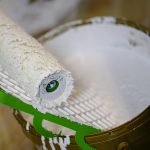Magnetic Paint Projects: Your New Favorite DIY
If you’ve ever wished your wall could double as a magnetic board, magnetic paint for walls might be the DIY solution you’ve been looking for.
With just a few coats, this specialty paint creates a surface that attracts magnets with no metal sheets or screws required. Magnetic paint is a great way to mix function with creativity, whether you’re setting up a magnetic calendar in the kitchen, a tool board in the garage, or a fun art wall to display your kid's art.
Here’s what you need to know before you start rolling.
What Is Magnetic Paint?
Magnetic paint (also called magnetic primer) is a latex-based paint infused with tiny iron particles. Once dry, it creates a surface that magnets will stick to; it’s like a chalkboard that works with magnets instead of chalk.
Magnetic paint is not actually magnetic. It doesn’t generate a magnetic field; it simply holds magnets when they’re placed on the surface. The strength of that hold depends on the number of coats and the magnets you use.
Where Can You Use Magnetic Paint?
Anywhere you’d usually paint! Just be sure the surface is smooth and flat. Some popular spots include:
- Garage walls (for tools, bits, or small parts)
- Kitchen command centers (hold notes, recipes, or photos)
- Home office walls (hang calendars, cables, or accessories)
- Craft rooms or studios (organize metal clips, scissors, and supplies)
Magnetic paint is especially handy when you don’t want to drill holes or install hardware and want the freedom to move things around.
How to Apply Magnetic Paint
You don’t need to be a pro to use it, but you’ll want to follow a few tips for best results.
What You’ll Need:
- Magnetic primer (Rust-Oleum Magnetic Primer is widely available)
- Stir stick (the iron settles quickly!)
- High-density foam roller
- Painter’s tape and drop cloth
- Optional: topcoat paint in your color of choice or chalkboard paint if you want the aesthetic of a chalkboard and the convenience of a magnet board.
Step-by-Step:
- Prep your surface
Make sure it’s clean, dry, and smooth. Sand lightly if needed. Tape off any trim or areas you don’t want to paint. - Stir thoroughly
Magnetic primer is thick and heavy. Stir frequently to keep the iron particles evenly mixed. If you purchase your paint at a home improvement store, stop at the paint counter first and have them mix the can for you. - Apply at least 3 coats
More coats = stronger magnetic hold. We recommend at least three, with 30–45 minutes between each. Let dry completely. - Top it off (optional)
Once your final coat is dry, you can paint over it with any latex paint color. Just know that the thicker the topcoat, the weaker the magnetic pull may be. - Start decorating
Use strong neodymium magnets to hold your items up. For best results, we recommend small disc or block magnets.
Recommended Apex Magnets:
- ¼” x ¼” Cylinder Neodymium Magnets - These have strong holding power and enough space for you to be able to grip in order to place and move your magnets. They were the perfect solution for this art gallery wall from Dream Green DIY we helped create.
- Brushed Chrome Magnetic Pins - These strong pins provide a polished or industrial-looking finish to your project.
- Medium Magnetic Jewel Pins—These pins come in various colors to add flair to your project.
Tip: Hang a large map in front of the magnetic paint and use different colors to mark places you’ve visited (and places you’re planning to go in the future). Visit all our pins and clips to view all the options. - Our selection of pins, hooks, and clips pairs perfectly with magnetic paint projects. You can choose what works best for your specific project, or give us a call for a recommendation.
Cautions & Things to Know
- Magnetic paint is dark gray, so it’s best used as a base coat unless you want an industrial look.
- The magnetic strength won’t hold heavy items; stick with notes, tools, or lightweight accessories.
- Always use neodymium (rare earth) magnets; fridge magnets or ceramic styles often aren’t strong enough.
- It’s safe for home use, but be sure to paint in a ventilated area and follow all label instructions.
- Neodymium magnets are not safe for children, so exercise caution if your project involves a place frequented by small children.
Magnetic paint opens up endless possibilities for stylish organization and smart displays without extra hardware. Whether you're turning your garage into a gear hub or building a magnetic art wall, this simple DIY upgrade makes everyday spaces feel a little more functional (and a lot more fun).
Shop Online or Contact Us with Specific Questions
We offer a vast selection of magnets, so be sure to browse through them to find the perfect options for your specific needs. Subscribe to our monthly newsletter! You’ll be among the first to receive notifications about our latest blogs and our latest magnet deals.
If you need further assistance or have questions, please don't hesitate to contact us.
Magnets can be dangerous. Neodymium magnets, especially, must be handled with care to avoid personal injury and damage to the magnets. Fingers and other body parts can get severely pinched between two attracting magnets. Bones can be broken by larger magnets.
Children should not be allowed to play with neodymium magnets as they can be dangerous. Small magnets pose a choking hazard and should never be swallowed or inserted into any part of the body.
Visit our Magnet Safety page to learn more.

